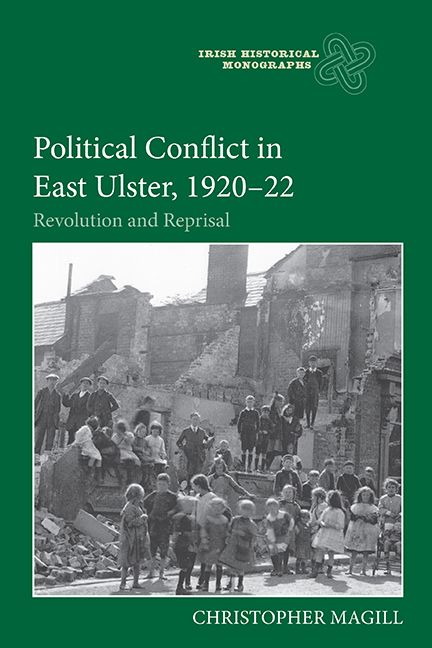Book contents
- Frontmatter
- Dedication
- Contents
- List of Illustrations
- Acknowledgements
- Abbreviations
- A Note on Terminology
- Map
- ‘Cork Justice Travelled a Long Way’: the Assassination of District Inspector Oswald Swanzy
- 1 From Moderates to Militants: the Unionist Community in East Ulster
- 2 Reprisal: the East Ulster Riots
- 3 ‘A Vital But Unenviable Task’: Understanding Loyalist Violence
- 4 A Protestant Force: the Social Composition of the B Specials
- 5 The Wilder the Better? Explaining the Violence of the Ulster Special Constabulary
- 6 A Misunderstood Minority: Irish Nationalists
- Conclusion
- Bibliography
- Index
- Irish Historical Monographs Previous Volumes
- Frontmatter
- Dedication
- Contents
- List of Illustrations
- Acknowledgements
- Abbreviations
- A Note on Terminology
- Map
- ‘Cork Justice Travelled a Long Way’: the Assassination of District Inspector Oswald Swanzy
- 1 From Moderates to Militants: the Unionist Community in East Ulster
- 2 Reprisal: the East Ulster Riots
- 3 ‘A Vital But Unenviable Task’: Understanding Loyalist Violence
- 4 A Protestant Force: the Social Composition of the B Specials
- 5 The Wilder the Better? Explaining the Violence of the Ulster Special Constabulary
- 6 A Misunderstood Minority: Irish Nationalists
- Conclusion
- Bibliography
- Index
- Irish Historical Monographs Previous Volumes
Summary
I
For centuries, Ulster stood apart from the rest of Ireland. Prior to the seventeenth-century Plantation, it remained under the rule of Gaelic lords, experiencing less English influence than Ireland's southern provinces. In the wake of the Plantation, and its nineteenth-century industrialisation, Ulster became Ireland's most Protestant and urbanised region. Visitors to Ireland noted major differences between north and south. In 1842 a German traveller described Drogheda as ‘the last genuine Irish [town]’ on his northward journey into Ulster, which he characterised as ‘a different world’ of pretty houses and cottages rather than cabins. Political differences became increasingly evident, with a notable hostility among many northern Protestants towards republicanism.
There was a ‘vast difference’ between north and south, as judged by one early twentieth-century American observer. Natives were also struck by the contrast. Revisiting Belfast after many years in Buenos Aires, William Bulfin observed:
As I stand within it I asked myself was I in Ireland. I thought of Henry Joy McCracken and of other men and other times, and could find nothing in my surroundings to feed such a train of thought. I saw churches of all denominations, Freemason and Orange Lodges, wide streets, towering smokestacks, huge factories, crowded traffic.
Belfast, he concluded, was ‘not an Irish city’. Many commentators were quick to note how little the north-east conformed to their understanding of what Ireland should look like. In religion, politics, industry, urbanisation and even accent – ‘a lingering on the r's was noticeable that had more of Glasgow in it than of Dublin’ – Ulster appeared distinct from the rest of Ireland. Consequently, the partitioning of Ireland in 1921 was not a bolt from the blue but rather a political expedient reflecting long-standing political, cultural, economic and religious differences between north and south.
This was most obviously demonstrated through social relations in Ulster, which were defined by a deep communal divide between Catholics and Protestants. Many of its inhabitants nonetheless portrayed their region as one where two groups of people lived – for the most part – in peace alongside each other, with discord only arising when political tensions came to the fore.
- Type
- Chapter
- Information
- Political Conflict in East Ulster, 1920–22Revolution and Reprisal, pp. 177 - 185Publisher: Boydell & BrewerPrint publication year: 2020



